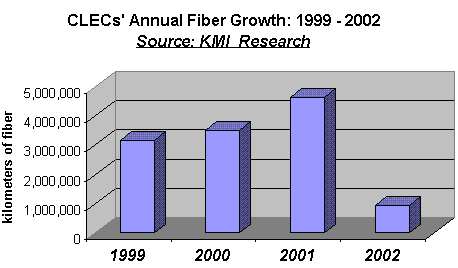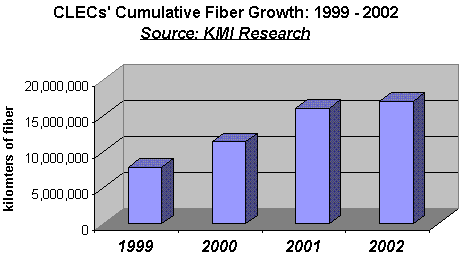Report: CLEC Fiber Still Growing
The CLEC market's been battered but remains a formidable challenge to incumbents, says KMI Research
June 19, 2003

Few carriers were hit as hard by the telecom downturn as the U.S. competitive local exchange carriers (CLECs). But a recent report from KMI Research says that CLECs with fiber facilities, while struggling, continue to offer formidable competition to the RBOCs (see CLEC Growth Slows, but Continues).
"Even in 2002, we saw a cumulative increase in fiber despite other problems," says KMI analyst and report author Michael Arden. Granted, the amount of new fiber being installed by CLECs was slashed as the bubble burst: By KMI's reckoning, 37 CLECs -- including the likes of Advanced TelCom Group Inc., BTI, Metromedia Fiber Network Inc.(MFN) (Nasdaq: MFNX), and XO Communications Inc. (OTC: XOXO) -- put in 4,650,000 kilometers of new fiber stateside in 2001, while in 2002, the same group installed 80 percent less, about 939,000 km.
At the same time, though, KMI's report, entitled "U.S. CLECs: Market Developments and Fiberoptic Systems Deployments," says the overall amount of fiber offered to customers by CLECs for a range of services has continued to climb and even rose modestly (6%) between 2001 and 2002.

Arden says CLECs have clearly struggled with their business models. At the same time, though, the larger ones have been able to manage overhead costs a bit more effectively than their RBOC competitors. Being newer and less tied to a range of infrastructure issues than are RBOCs, the survivors have been swifter to cut costs as needed -- and to pass on savings in prices that undercut the incumbents.
Bottom line? Even though CLECs aren't building out facilities like they did in the boom time, their presence is growing. Indeed, KMI says CLEC service has expanded to more than 200 cities in the U.S. since 2000 -- and most of those cities are among the nation's largest, the so-called top-tier markets.
On the downside, the future remains uncertain. [Ed. note: Isn't it always?] Even though the CLEC market has survived, many individual companies within it have perished. As the downturn continues, the competitive scene in the U.S. is likely to squeeze out even more CLECs before the final winnowing is done.
— Mary Jander, Senior Editor, Light Reading
You May Also Like










